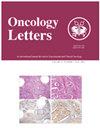Identification and validation of PCDHGA12 and PRRX1 methylation for detecting lung cancer in bronchial washing sample.
IF 2.2
4区 医学
Q3 ONCOLOGY
引用次数: 0
Abstract
Bronchoscopy is a frequently used initial diagnostic procedure for patients with suspected lung cancer (LC). Cytological examinations of bronchial washing (BW) samples obtained during bronchoscopy often yield inconclusive results regarding LC diagnosis. The present study aimed to identify molecular biomarkers as a non-invasive method for LC diagnosis. Aberrant DNA methylation is used as a useful biomarker for LC. Therefore, microarray-based methylation profiling analyses on 13 patient-matched tumor tissues at stages I-III vs. non-tumor tissues were performed, and a group of highly differentially methylated genes was identified. A subsequent analysis using bisulfite-pyrosequencing with additional tissues and cell lines revealed six methylated genes [ADAM metallopeptidase with thrombospondin type 1 motif 20, forkhead box C2 (mesenchyme forkhead 1), NK2 transcription factor related, locus 5 (Drosophila), oligodendrocyte transcription factor 3, protocadherin γ subfamily A 12 (PCDHGA12) and paired related homeobox 1 (PRRX1)] associated with LC. Next, a highly sensitive and accurate detection method, linear target enrichment-quantitative methylation-specific PCR in a single closed tube, was applied for clinical validation using BW samples from patients with LC (n=68) and individuals with benign diseases (n=33). PCDHGA12 and PRRX1 methylation were identified as the best-performing biomarkers to detect LC. The two-marker combination showed a sensitivity of 82.4% and a specificity of 87.9%, with an area under the curve of 0.891. Notably, the sensitivity for small cell LC was 100%. The two-marker combination had a positive predictive value of 93.3% and a negative predictive value of 70.7%. The sensitivity was higher than that of cytology, which only had a sensitivity of 50%. The methylation status of the two-marker combination showed no association with sex, age or stage, but was associated with tumor location and histology. In conclusion, the present study showed that the regulatory regions of PCDHGA12 and PRRX1 are highly methylated in LC and can be used to detect LC in BW specimens as a diagnostic adjunct to cytology in clinical practice.鉴定和验证 PCDHGA12 和 PRRX1 甲基化在支气管清洗样本中检测肺癌的作用。
支气管镜检查是疑似肺癌(LC)患者常用的初步诊断方法。支气管镜检查过程中获得的支气管冲洗(BW)样本的细胞学检查往往不能得出肺癌诊断的最终结果。本研究旨在确定分子生物标志物,作为诊断肺癌的一种非侵入性方法。畸变的DNA甲基化可作为LC的有效生物标志物。因此,研究人员对 13 例患者匹配的 I-III 期肿瘤组织与非肿瘤组织进行了基于芯片的甲基化谱分析,并确定了一组高度差异化的甲基化基因。随后对其他组织和细胞系进行了亚硫酸氢盐-多测序分析,发现了六个甲基化基因[ADAM 金属肽酶与血栓软蛋白 1 型主题 20、叉头框 C2(间质叉头 1)、NK2 转录因子相关基因,基因座 5(果蝇)、少突胶质细胞转录因子 3、原粘连蛋白 γ 亚家族 A 12(PCDHGA12)和成对相关同源染色体 1(PRRX1)]与 LC 相关。接下来,一种高灵敏度、高准确度的检测方法--在单个封闭试管中进行线性目标富集-甲基化特异性定量 PCR--被应用于临床验证,其样本来自 LC 患者(68 人)和良性疾病患者(33 人)。结果表明,PCDHGA12 和 PRRX1 甲基化是检测 LC 的最佳生物标记物。两个标记物组合的灵敏度为 82.4%,特异性为 87.9%,曲线下面积为 0.891。值得注意的是,小细胞 LC 的灵敏度为 100%。双标记组合的阳性预测值为 93.3%,阴性预测值为 70.7%。灵敏度高于细胞学,后者的灵敏度仅为 50%。双标记物组合的甲基化状态与性别、年龄或分期无关,但与肿瘤位置和组织学有关。总之,本研究表明 PCDHGA12 和 PRRX1 的调控区在 LC 中高度甲基化,在临床实践中可用于检测 BW 标本中的 LC,作为细胞学检查的辅助诊断方法。
本文章由计算机程序翻译,如有差异,请以英文原文为准。
求助全文
约1分钟内获得全文
求助全文
来源期刊

Oncology Letters
ONCOLOGY-
CiteScore
5.70
自引率
0.00%
发文量
412
审稿时长
2.0 months
期刊介绍:
Oncology Letters is a monthly, peer-reviewed journal, available in print and online, that focuses on all aspects of clinical oncology, as well as in vitro and in vivo experimental model systems relevant to the mechanisms of disease.
The principal aim of Oncology Letters is to provide the prompt publication of original studies of high quality that pertain to clinical oncology, chemotherapy, oncogenes, carcinogenesis, metastasis, epidemiology and viral oncology in the form of original research, reviews and case reports.
 求助内容:
求助内容: 应助结果提醒方式:
应助结果提醒方式:


